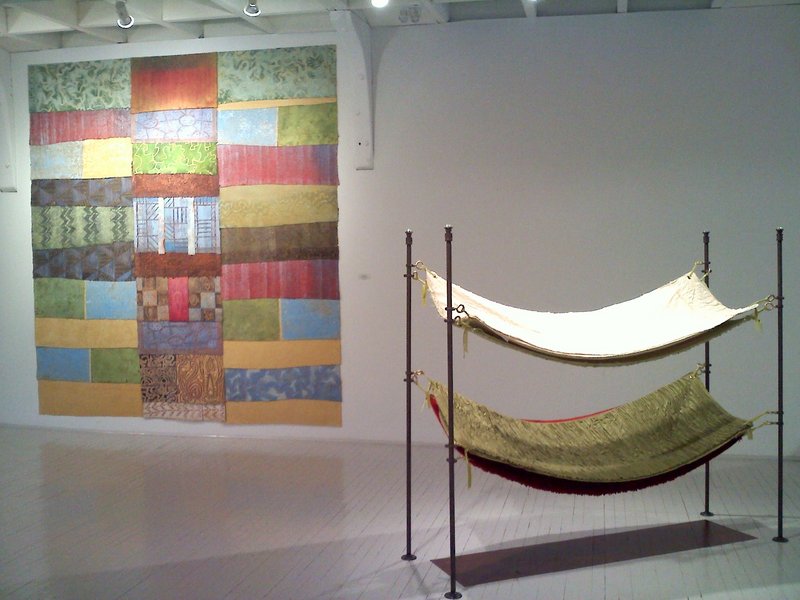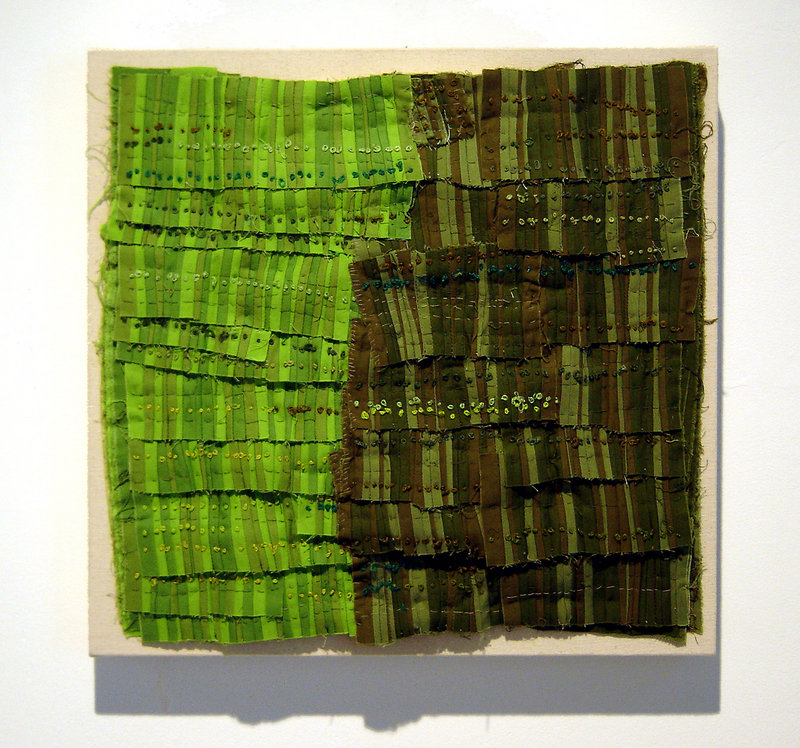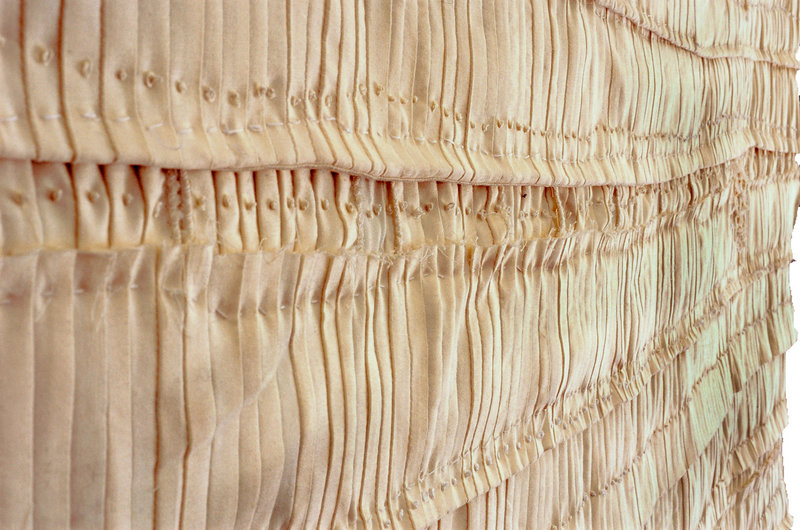I have always liked the Center for Maine Contemporary Art. I was worried when it was on the ropes for a while, but against the odds and above all expectations in such economically lean times, it seems more alive than ever.
Each of the four shows currently on view at the CMCA is markedly original, aesthetically strong and completely different from the others.
What stands out most for me, however, is the work of Gabriella D’Italia, which makes up half of “Pieced” — a two-person show in the main gallery loosely based on quilting and tapestry.
Most of D’Italia’s work is quilted fabric. It is labor intensive, vastly complex, technically rigorous and yet still — somehow — understated. One of my favorite works is “White Finery,” a 60-inch square of quilted, pieced and embroidered white sateen. In many ways, it’s a great monochrome painting in the wake of Malevich or later minimalist painters. But it’s all that and so much more.
Its visual logic stems from the 20 or so overlapping horizontal bands. D’Italia uses the soft cloth to give the piece an overall feel while, counter-intuitively, her detailing only unifies it further. In a way, she almost trumps the great monochrome painters such as Ad Reinhardt and Yves Klein, given that their work was less about being unified than acting unified.
But it doesn’t stop there. Much of D’Italia’s work is loose on the edges to reveal that the surface is sitting on as many as 10 or more layers — which results in a sense of supremely lush substance. And still, the artist plays up the intense process-oriented content of her work through references to the medium, personal skill and the notion of the modernist grid.
Adding these qualities together delivers a keen sense of time — not the regular clock of muscle-memory knitting or embroidery, but something more self aware to the point of existential obsessiveness.
Finally, three small areas of chaos and subtle tumult come into view in the lower right of the piece — even including bits of yellow thread and diagonal movements. These are paroxysms of life; moody moments that play different roles if you think of the piece as a present whole or if you see it as the slow, indexical process calendar of the artist’s labor. It’s less that D’Italia transforms the material than brings it alive.
Of the 12 pieces in the show, only five fall into this painterly mode — including several wittily mounted on raw canvas stretchers. The other works take off in some new directions dealing with issues of domestic space, gender, repetition and modularity.
D’Italia’s new “Portables” are sculptural works combining steel pipe armatures with her quilts and site-painted rectangles. For example, her “Cot” features two steel banisters supporting fabric over a metallic bronze rectangle painted on the floor. The U-shaped hammock is bunched white sateen on top with rich scarlet below.
While “Cot” refuses to be narrative, it mobilizes some clear conceptual pairs such as inside/outside, top/bottom, metal/cloth, painting/sculpture and public/private space, among others. The result is a surprisingly subtle commentary on gender and sexual roles.
“Screen” and “Tent” further these conversations about sexuality, interiority and gender distinctions on subtle, even fleeting, terms. While “Tent” can be seen simply as a plethora of sperm (18 gold-painted “6 1/2 lb” window weights) surrounding a female form, it also connotes paired metaphors such as male = thing/female = space, or female = interior/male = exterior. But for all its brilliance, D’Italia’s sexual imagery is quiet, beautiful and even romantic. It’s better than art; it’s intellectual craft at its finest.
While Mason’s work is a gorgeous match with D’Italia’s, his suffers for the pairing. His works are richly textured and brightly painted plaster on burlap segments that are hung one over the next like pieced quilts. They are large, mostly exuberant, and often crackled, pocked and finished with encaustic and casein paints.
When Mason composes pieces using color, such as in his “100 Meetings,” they surrender their subtlety to decoration. But when they stay monochromatic, such as in his giant ochre “Shelter” and his green “Nourishing the Old,” the works draw you in close and treat you to a ravishing smorgasbord of texture and detail.
Combining video, sculpted steel vehicles, prints and photographs, Deborah Wing-Sproul’s “still/moving” is a small but heady and striking installation about her performance making the prints in the show.
Zach Poff’s and N.B. Aldrich’s “Sferics and Aural Ecosystem” is a high-tech installation in which sferics (broadband radio impulses produced by atmospheric lightning) are captured and used to guide light and sounds via a complex series of fixtures and speakers on stands mounted throughout the room.
The installation has the look and feel of a mad scientist’s laboratory, especially with its listening station, shifting lights, ubiquitous wires and intentionally oblique computer control station.
Best of all, however, are the sounds generated by the sferics as they range from softly crumbling static to angry swarms of humming bees. It’s an exciting reminder that the electromagnetic world is constantly swirling all around us.
While D’Italia, one of Maine’s most promising young artists, alone makes the trip worthwhile, the entire facility looks great and feels energized. It’s a fantastic time to visit the CMCA.
Freelance writer Daniel Kany is an art historian who lives in Cumberland. He can be contacted at:
dankany@gmail.com
Send questions/comments to the editors.





Success. Please wait for the page to reload. If the page does not reload within 5 seconds, please refresh the page.
Enter your email and password to access comments.
Hi, to comment on stories you must . This profile is in addition to your subscription and website login.
Already have a commenting profile? .
Invalid username/password.
Please check your email to confirm and complete your registration.
Only subscribers are eligible to post comments. Please subscribe or login first for digital access. Here’s why.
Use the form below to reset your password. When you've submitted your account email, we will send an email with a reset code.